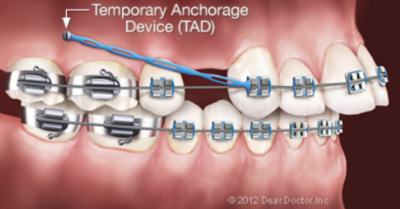Temporary Anchorage Devices
 When it comes to orthodontic treatment, temporary anchorage devices, or TADS, are an oldie but a goodie. Orthodontists have used them since the 1980s, but they are gaining widespread acceptance today because of the potentially groundbreaking benefits they offer some patients.
When it comes to orthodontic treatment, temporary anchorage devices, or TADS, are an oldie but a goodie. Orthodontists have used them since the 1980s, but they are gaining widespread acceptance today because of the potentially groundbreaking benefits they offer some patients.
Essentially, TADS are small, screw-like dental implants made of a titanium alloy. As the name implies, they are temporary—they usually remain in place during several months of orthodontic treatment, after which they are removed. TADS provide a stable, fixed point around which teeth can be moved. When possible, orthodontists will use the back teeth as an anchor to move other teeth in the jaw. Under certain circumstances headgear may be required to provide the necessary anchorage, but in many cases TADS can change that.
What Can TADS Do?
Although it is the general preferred practice, using teeth as orthodontic anchors can have drawbacks in some cases. For example, there may not be a viable tooth located at the point where an anchor is needed. Additionally, when greater force is required the teeth used as anchors could themselves begin to move out of place. TADS implants can eliminate the need to use teeth as anchors and/or stabilize teeth that have moved out of place.
Now let's talk orthodontic headgear. Orthodontic headgear provides a necessary anchorage point from outside the mouth. However, headgear can be uncomfortable, and compliance is sometimes a problem. In many situations, TADS can be used as a much-less-intrusive alternative to headgear, which is a welcome development for many patients and parents too.
TADS offer even more benefits, including:
- Shortening overall orthodontic treatment time
- Eliminating the need to wear elastics (rubber bands)
- Making certain oral surgeries unnecessary
- Reducing and maybe even eliminating the need for elastic wear
- Allowing orthodontists to take on more complex cases
Getting & Maintaining TADS
TADS are small, screw-like devices that are placed into the bone of the jaw, similar to dental implants. Unlike implants, however, they don't always need to become integrated with the bone itself. They are much easier to put in and fix in place, then remove when orthodontic treatment is complete. Furthermore, placing TADS is a minimally-invasive, pain-free procedure that takes just minutes to complete. After the area being treated is numbed, a patient feels only gentle pressure as the device is inserted. Most patients do fine following the procedure, but an over-the-counter pain reliever can be taken if needed. And note that taking out TADS later on is even easier!
 While TADS are in place they may require a bit of maintenance on top of your normal oral hygiene routine. Generally, they should be brushed daily with a soft toothbrush dipped in an antimicrobial solution. Your orthodontist will give you specific instructions regarding maintenance when your TADS are placed.
While TADS are in place they may require a bit of maintenance on top of your normal oral hygiene routine. Generally, they should be brushed daily with a soft toothbrush dipped in an antimicrobial solution. Your orthodontist will give you specific instructions regarding maintenance when your TADS are placed.
A Temporary Treatment with Permanent Results
Not every orthodontic patient needs TADS, but for those who do, it's a treatment option that offers clear benefits. If you have any questions about the procedure or braces in general, please feel free to contact us! We are always glad to talk with you and address your concerns over the phone or in-person at our offices in Winter Park and Orlando, FL.
